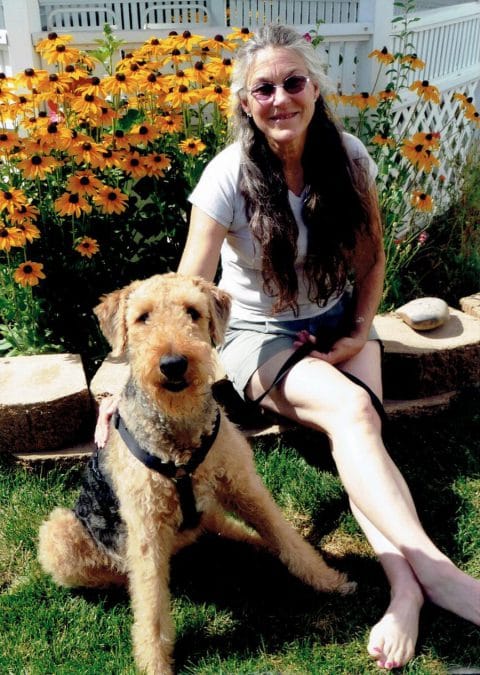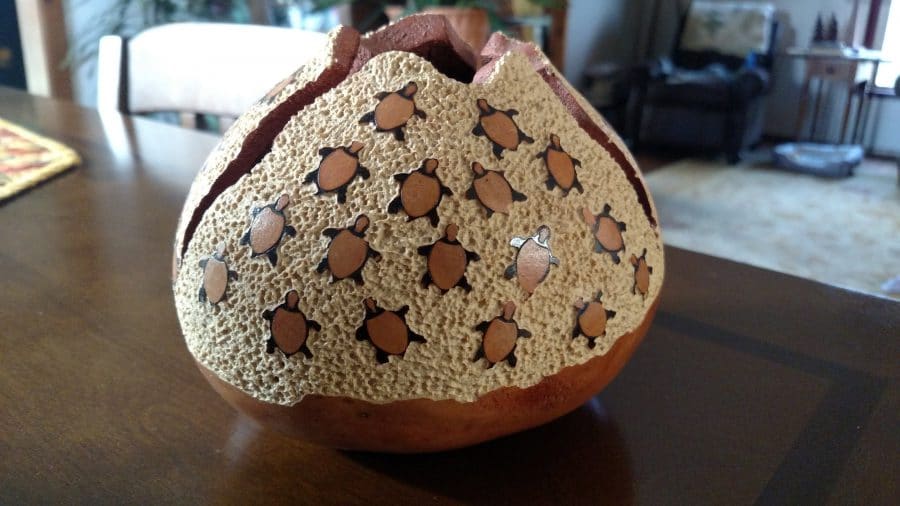Geckos, fruit, horses, feathers, birdhouses, peacocks, and giraffes — those are only a few customer requests gourd artist Susan Appier has received throughout her career. Over the last 13 years, the Bostick family descendant worked to perfect her artistic skills, including watercolor painting, stenciling, burning in designs and more.
Appier built a business for herself, turning clients’ ideas into unique pieces of functional or decorative art. But why gourds?

“I’ve made lamps out of them. I’ve made canister sets. I’ve made little jewelry boxes. … They’re very versatile,” she said. “You can make banks for children. I’ve done all sorts of things. I’ve made nightlights. And each gourd is different, and it takes the dyes differently, and it intrigues me.”
Apart from their versatility, Appier appreciates using a natural, water-based medium. She started watercolor painting at 6 years old in the late 1950s. A local shop owner in her hometown let Appier take a beginner’s set with her one day and put the cost on her store account. Appier’s mother and neighbors paid her for chores to buy the supplies, and she remembers the set cost $5.19.
Watercolor remains her favorite painting style.
Appier’s artistic motto is, “Create beauty that will make people smile.” She even printed it on her business cards, which sit in a holder made from a gourd.
Rattles and warts
Appier drew from the time she could hold a pencil and painted long before she discovered her new favorite medium.
While living in New Mexico, Appier attended a rattle-making class in the mid-2000s taught by a Nambé and Pojoaque Pueblo elder. The style passed down for generations included cleaning and drilling holes in a gourd as the container for the pebbles that make the signature sound. Potawatomi and Nishnabé people also use rattles in traditional music, and the class gave Appier her first experience with gourd art.
“The whole process fascinated me. So I moved on to buying equipment — gourd saws, specifically, and the tools specifically for gourds,” she said. “So, I have all kinds of gourds, from little tiny jewelry gourds to very large.”
In 2006, she and her sister visited a gourd festival in Albuquerque, New Mexico, where Appier became inspired. Her sister bought Appier the first burning kit she owned, and Appier gave her the first gourd she painted as a gift.
“It was a wart gourd that had bumps all over it. I made a little face on it and used one of the bumps as a nose. Yeah, it’s pathetic looking,” Appier said and laughed. “But bless her heart. She’s kept it all these years. … But I have come a long way; I know. It’s like, ‘Why would you keep that?’ She goes, ‘Because you made it, and you’re my sister.’”
Not long after, Appier entered several gourd pieces into the Santa Fe County Fair art contest for the first time. Some of them she burned, and some she painted. She won five first-place awards and two best of show ribbons.

“Dried pumpkins”
While Appier’s business has grown throughout the last decade, she continues to work a full-time job where she lives in Arizona. Her art consumes much of her time as well, and cleaning and preparing the gourds for burning or painting requires diligence.
“When you open them up, they are like a dried pumpkin inside,” Appier said. “Some of them are really hard to clean, and some gourds I have 30 and 40 hours in them. And it depends on the size, and some gourds are softer shelled, so they’re easier to clean.”
She considers her clients’ requests on their intended use for the gourd and their ideas for themes, opening herself to all suggestions. She recently raffled off an apple gourd covered in strawberries. Appier turned it into a bowl filled with different kinds of fruit.
“Each one is completely different on how it’s going to take the paint and the dyes. Some of them I use acrylics, water-based acrylics, and then other ones I use the gourd dyes,” Appier said.
“Some will take white easier. The harder shells won’t take the color white in the dyes like the softer shells do.”
Welburn Gourd Farm in California provides the gourds as well as many of her supplies, including her new burner, dyes and paints. She purposefully selects non-toxic and chemical-free products.
Appier looks forward to working on orders in the art studio she opened in her back yard earlier this year. With a dedicated space for her watercolor paintings and gourd art, she anticipates spending even more time creating “beauty that will make people smile.”
“I’m very blessed,” she said.
For more information, or to place an order, email suzyappier@msn.com. Type “Gourd Inquiry” in the subject line, and include contact information.
